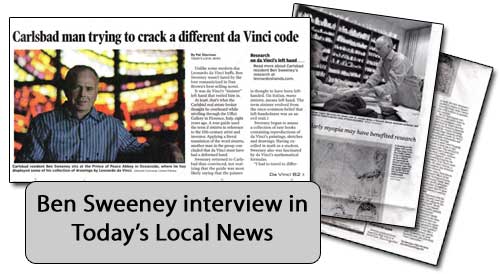Unlike some modern-day Leonardo da Vinci buffs, Ben Sweeney wasn’t lured by the lore romanticized in Dan Brown's best-selling novel. It was da Vinci’s “sinister” left hand that reeled him in. At least, that's what the Carlsbad real estate broker thought he overheard while strolling through the Uffizi Gallery in Florence, Italy, eight years ago. A tour guide used the term il sinistra in reference to the 15th-century artist and inventor. Applying a literal translation of the word sinistra, another man in the group concluded that da Vinci must have had a deformed hand. Sweeney returned to Carlsbad thus convinced, not realizing that the guide was most likely saying that the painter is thought to have been left-handed. (In Italian, mano sinistra, means left hand. The term sinister evolved from the once-common belief that left-handedness was an evil trait.) Sweeney began to amass a collection of rare books containing reproductions of da Vinci's paintings, sketches and drawings. Having excelled in math as a student, Sweeney also was fascinated by da Vinci's mathematical formulas. The code in the codex Earlier this month, Sweeney displayed one of the hefty volumes in the library of the Prince of Peace Abbey in Oceanside, where his mother, Dolores, once found solace in the picturesque grounds. In 1999, the family dedicated a set of stained glass windows there in her name. Sweeney often visits to speak with the monks or to ruminate on his da Vinci studies. “My mother would make the journey here daily and knew all the priests,” Sweeney said. “It's a very important place to me.” The nearly 2,000 drawings in the Codex Atlanticus are first facsimiles reproduced by monks in Italy. The volume Sweeney brought with him contains a red chalk sketch of da Vinci's so-called “weary hand” holding a stylus. Though art historians have long believed the oddly shaped hand to be indicative of a stroke da Vinci had late in life, Sweeney sees something different — fused third and fourth fingers, a trait characteristic of syndactyly, a condition in which two or more digits are joined together. Sweeney believes a faint, broken line between the two fingers that appears to separate them is actually an imperfection in the paper. “That's a syndactyly hand,” he said. “Historians had always seen photographs of this, but no one got to see the (original) red chalk drawing till these came out. Whenever they put it in books ... they just assumed there was a line here. They would draw what’s known as the interdigital crease to make it look more like a normal hand.” ABC interviewed Sweeney recently about his theory for its series “Primetime: Medical Mysteries.” During the show, Dr. Joseph Upton, a Harvard clinical associate professor and hand surgeon, commented on the “crooked” ring finger in da Vinci's drawing. Though Sweeney's theory may never be proved, Upton said he believes the drawing appears to be that of a syndactyl hand. In the restored version of “The Last Supper,” Christ appears to be gazing directly at his malformed left hand as he contemplates his fate. ‘More than possible’ A personal quest Sweeney's father, Andrew, a retired engineer, serves as a sounding board for his exploration of da Vinci's math studies. He sister Dolores, a retired surgeon, has reviewed his hand research. Another sister, Paula Brock, chief financial officer of the San Diego Zoological Society, said the Sweeney family likes to serve as devil's advocates for one another. In regard to da Vinci’s hand, they’ve gone from incredulous to amazed, Brock said. “We’re impressed with his focus, the scholarly level and the people with whom he has associated himself,” Brock said. “As time has elapsed, through the tangible analysis, we were mesmerized.” Though Sweeney's family has been receptive to his ideas, some art historians have not. “When I went to one expert ... he became agitated to think that Leonardo wasn't perfect,” Sweeney said. “I was like a little kid, all excited, and he said, ‘Leonardo’s the most beautiful man who ever lived. That's impossible.’” Copyright © 2007 Benedict J. Sweeney all rights reserved Top of Page |
|
|
| Publications |
| Search |
